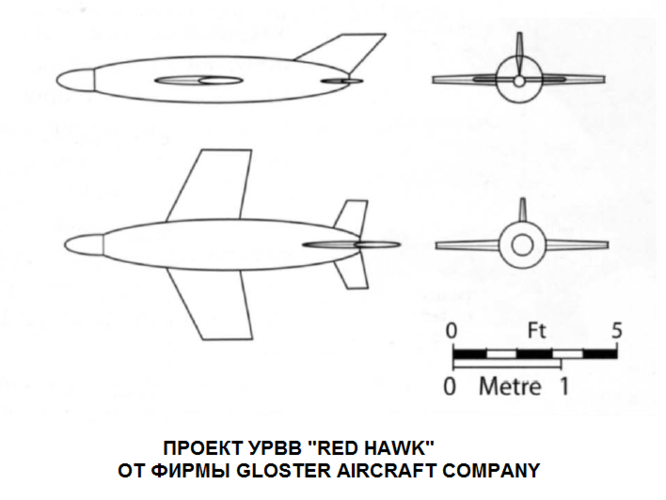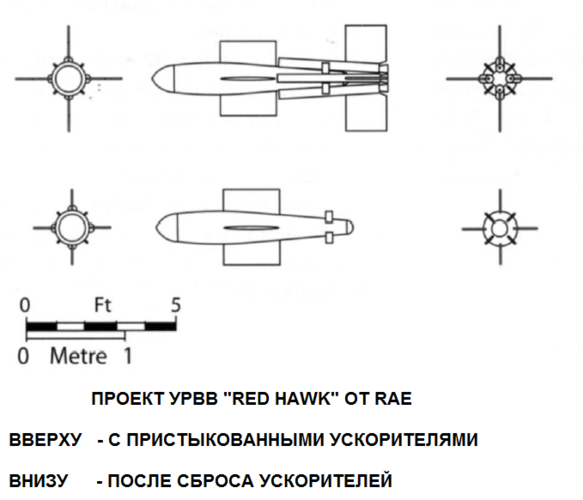It's mentioned on the Fireflash missile wikipedia page that it had been a watered down version of the , and I quote "beyond state of the art" Red Hawk missile which had an all-aspect capability. Does anyone know why the Red Hawk 1947 edition wasn't kept? Apologies if this post is a bit informal , I'm quite new to the Secret Projects website
You are using an out of date browser. It may not display this or other websites correctly.
You should upgrade or use an alternative browser.
You should upgrade or use an alternative browser.
Red Hawk Missile
- Thread starter lelman
- Start date
- Joined
- 27 December 2005
- Messages
- 16,415
- Reaction score
- 18,962
Red Hawk was ambitious beyond the capabilities of industry to make. It would have taken lots of money for research and development, and much time. The decision was made to proceed in smaller, easier steps.
Dilandu
I'm dissatisfied, which means, I exist.
Mainly because of size. It was supposed to be a semi-active radar homing missile, which would home on the echo of AI Mk.IX aerial interception radar. And to work with it, the missile antenna must be HUGE. It was estimated, that dish diameter of 91 cm (36 inches!) was required to actually achieve all-aspect interception on meaningful ranges. The diameter of the whole missile therefore would be more than a meter.It's mentioned on the Fireflash missile wikipedia page that it had been a watered down version of the , and I quote "beyond state of the art" Red Hawk missile which had an all-aspect capability. Does anyone know why the Red Hawk 1947 edition wasn't kept? Apologies if this post is a bit informal , I'm quite new to the Secret Projects website
Two competing proposals were prepared by Gloster and RAE, but neither was actually very promising:
NOTE: the illustrations are from British Secret Projects - Hypersonics, Ramjets & Missiles by Chris Gibson and Tony Buttler, with Russian text added for convenience of Russian readers.

NOTE: the illustration is from British Secret Projects - Hypersonics, Ramjets & Missiles by Chris Gibson and Tony Buttler, with Russian text added for convenience of Russian readers.
Gloster suggested essentially a small winged drone, with liquid fuel rocket engine, hanging on the special trapeze semi-recessed into the weapon bay of interceptor. It was supposed to be lowered on the trapeze before launch.

NOTE: the illustration is from British Secret Projects - Hypersonics, Ramjets & Missiles by Chris Gibson and Tony Buttler, with Russian text added for convenience of Russian readers.
RAE suggested engine-less missile with cruciform wing and X-shaped tail, which was supposed to be accelerated by a bunch of four solid-fuel rocket boosters, which would then detach, and missile continue to travel by inertia.
Essentially both projects came to nothing, because AI Mk.IX radar continued to be problematic, the size requirements were too much, and the problem of tracking the target on head-on combined velocities were greater than anticipated. The project was downscaled to the chase attack only "Pink Hawk" and eventually cancelled, because "Long Shot" (the future "Fairey Fireflash") was already much more advanced and offered similar capabilities.
Last edited:
Dilandu
I'm dissatisfied, which means, I exist.
You could find a lot of data about British WW2-era AAM's in my articles (on Russian):
https://fonzeppelin.livejournal.com/64517.html
https://fonzeppelin.livejournal.com/65356.html
https://fonzeppelin.livejournal.com/64517.html
https://fonzeppelin.livejournal.com/65356.html
Maury Markowitz
From the Great White North!
- Joined
- 27 February 2014
- Messages
- 181
- Reaction score
- 111
There is something wrong with this statement. Both images show a missile with a nose cone diameter of about a foot or less. I’m also not clear why you need a large antenna on the missile, it seems more likely one needed this on the fighter in order to reduce the beam width. This assumes semi active in this case is a beam rider, I am entirely unclear on how one might arrange a true semi-active system with Mk IX give it used conical scanning for lock-on.Mainly because of size. It was supposed to be a semi-active radar homing missile, which would home on the echo of AI Mk.IX aerial interception radar. And to work with it, the missile antenna must be HUGE. It was estimated, that dish diameter of 91 cm (36 inches!) was required to actually achieve all-aspect interception on meaningful ranges. The diameter of the whole missile therefore would be more than a meter.
John Ernst
ACCESS: Restricted
- Joined
- 20 October 2020
- Messages
- 4
- Reaction score
- 1
Your Russian pages do not translate in English. Do you have a translation. I want to use it for a book i am working on.You could find a lot of data about British WW2-era AAM's in my articles (on Russian):
https://fonzeppelin.livejournal.com/64517.html
https://fonzeppelin.livejournal.com/65356.html
Dilandu
I'm dissatisfied, which means, I exist.
Alas, no. My English is reasonably good, but not that good.Do you have a translation.
Don't forget the credits)want to use it for a book i am working on.
- Joined
- 26 May 2011
- Messages
- 2,105
- Reaction score
- 2,677
Where did you find these drawings?
Chris
John Ernst
ACCESS: Restricted
- Joined
- 20 October 2020
- Messages
- 4
- Reaction score
- 1
Of course not. I wil mention you.Alas, no. My English is reasonably good, but not that good.Do you have a translation.
Don't forget the credits)want to use it for a book i am working on.
- Joined
- 6 November 2010
- Messages
- 4,221
- Reaction score
- 3,142
The Red Hawk drawings were copied from page 31 of British Secret Projects - Hypersonics, Ramjets & Missiles by Chris Gibson and Tony Buttler, Midland 2007. Originally with English captions though, not the Russian ones seen here. It would be nice to give credit where credit is due.Of course not. I wil mention you.Alas, no. My English is reasonably good, but not that good.Do you have a translation.
Don't forget the credits)want to use it for a book i am working on.
(edit) After a very cursory glance - other images on fonzeppelin from the same source
(edit2) To be fair, BSP4 is mentioned there as a source.
Last edited:
Dilandu
I'm dissatisfied, which means, I exist.
I always credit the sources.(edit2) To be fair, BSP4 is mentioned there as a source.
Dilandu
I'm dissatisfied, which means, I exist.
My bad. I missed his post. My apologies.That's good. However, CJGibson - Chris Gibson, BSP4's co-author - asked you twice where you found the images. So I wrote in reply.
Dilandu
I'm dissatisfied, which means, I exist.
To clarify: the drawings above are from "British Secret Projects - Hypersonics, Ramjets & Missiles", with Russian text added for convenience of Russian readers. My article (in LiveJournal) about those missiles specifically credit British Secret Projects as one of the main sources.
My apologies for any misunderstanding.
My apologies for any misunderstanding.
- Joined
- 26 May 2011
- Messages
- 2,105
- Reaction score
- 2,677
Thank you. Had you contacted me beforehand, I could have provided you with better, clean, sharp drawings rather than the rather poor fuzzy photocopies, that really do detract from the quality of your site. I would much rather see my drawings in their crisp glory.To clarify: the drawings above are from "British Secret Projects - Hypersonics, Ramjets & Missiles", with Russian text added for convenience of Russian readers. My article (in LiveJournal) about those missiles specifically credit British Secret Projects as one of the main sources.
My apologies for any misunderstanding.
Many members of this forum have been provided with my drawings, on request. I might even have done the captions in Russian for you.
Technically, you should be crediting each image. Also, if you use drawings from me, you'll avoid the wrath of the mods for posting photocopies of parts of Ian Allan books, They take a dim view of that. So does the publisher.
One request - please add a note in English as to the source, to avoid any future confusion, which John Ernst appears have, about the origin these drawings.
Have you contacted Adrian Mann about using his artwork?
Chris
Last edited:
Dilandu
I'm dissatisfied, which means, I exist.
Thank you, I did not know about such possibility.Thank you. Had you contacted me beforehand, I could have provided you with better, clean, sharp drawings rather than the rather poor fuzzy photocopies, that really do detract from the quality of your site. I would much rather see my drawings in their crisp glory.
Hm, I though it would be enough to mention the sources. Okay, I took notice in future to attribute more properly (and I though I was doing a good work by actually mentioning all sources in my articles... apparently there is always room for improvementTechnically, you should be crediting each image.
One request - please add a note in English as to the source, to avoid any future confusion, which John Ernst appears have, about the origin these drawings.
Okay.
Similar threads
-
-
-
-
-
AIM-9 Sidewinder "SWIFT" modification?
- Started by Flame2512
- Replies: 7
